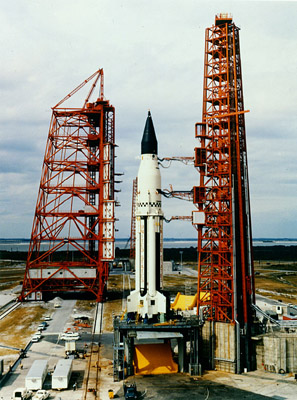
| SA-5: Block II Saturn I at Complex 37 |
It is December 15th of 1963, and a Saturn I (Block II) is being prepared for launch at Complex 37, Pad B for unmanned mission SA-5. The Saturn I is the predecessor of the more powerful Saturn IB, and the famous Saturn V that launched the Apollo lunar missions. The Saturn I was originally called the "Juno V", but was designated "Saturn C-1" in 1959. It was subsequently shortened to "Saturn I" in 1963.
The first stage consisted of a Jupiter tank surrounded by a cluster of eight Redstone tanks. This configuration was jokingly referred to as "Cluster's Last Stand." The Saturn I as flown in its first missions was a "Block I" vehicle, with 1.3 million lbs. of thrust, and dummy upper stages. The "Block II" vehicle, first flown in unmanned mission SA-5, featured an uprated first stage, stabilizing fins, and live upper stages.
The SA-5 mission was originally scheduled for January 27, 1964. Problems with the LOX system in the first stage delayed the launch by two days. When launched on the 29th, the mission was a success, meeting the objective of a flight test for the S-IV second stage.